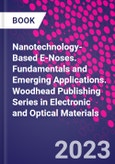Nanotechnology-based E-Noses reviews advances in nanomaterials and their modification for use in e-sensors. "E-noses" or "electronic sensors" are emerging as advanced technologies for the fast detection of chemicals, gases, and explosives. The concept behind the "e-nose" is similar to the capability of humans and dogs in detecting materials based on odors. Nanomaterials can be used for e-nose technologies but their properties must be modified to make them effective sensors. The sensing capability and performance of these materials depend on several factors, such as morphology, dopants, microadditives, design of sensors, phase, and structure of the nanomaterials.
Theoretical understanding of nanomaterials and technologies for improving sensors with better detection limits are covered. The most relevant nanomaterials, their synthesis strategies, and the relationship between properties and device performance are provided. Current state-of-the-art progress in nanotechnology device fabrication along with directions for future applications and challenges are discussed.
Please Note: This is an On Demand product, delivery may take up to 11 working days after payment has been received.
Table of Contents
Section 1
Basics principals
1. E-noses: an introduction
2. Introduction to nano-e-nose
3. Emerging applications of nanotechnology for e-nose
4. Multiarray nanopatterned (top-down nanolithography) e-nose
5. Recent advances in bioelectronic noses based on olfactory receptors
6. Chemical sensors based on two-dimensional materials
7. Thermoelectric nanomaterials for temperature gradient sensing (heat nose)
8. Hierarchical semiconductor-based nanostructures for e-nose
9. Biotechnology for e-noses: types and biomaterials
Section 2
Emerging applications
10. E-nose-based technology for healthcare
11. Sensors and electronic noses for the production of agricultural crops
12. E-noses for agri-food productions
13. Organic electronic nose applied to food traceability, adulteration, and authenticity
14. Application of piezoelectric e-noses for diagnostics of animal and human health
15. Role of gas sensor an integrated part of e-nose for online monitoring of air grade
16. Chemical sensors for e-nose: an effective route for disease diagnosis
17. Novel use of e-noses for digital agriculture, food, and beverage applications
18. Current perspectives of e-noses








